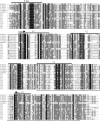Expression of 10 S-class SLF-like genes in Nicotiana alata pollen and its implications for understanding the pollen factor of the S locus
- PMID: 17947432
- PMCID: PMC2219507
- DOI: 10.1534/genetics.107.076885
Expression of 10 S-class SLF-like genes in Nicotiana alata pollen and its implications for understanding the pollen factor of the S locus
Abstract
The S locus of Nicotiana alata encodes a polymorphic series of ribonucleases (S-RNases) that determine the self-incompatibility (SI) phenotype of the style. The pollen product of the S locus (pollen S) in N. alata is unknown, but in species from the related genus Petunia and in self-incompatible members of the Plantaginaceae and Rosaceae, this function has been assigned to an F-box protein known as SLF or SFB. Here we describe the identification of 10 genes (designated DD1-10) encoding SLF-related proteins that are expressed in N. alata pollen. Because our approach to cloning the DD genes was based on sequences of SLFs from other species, we presume that one of the DD genes encodes the N. alata SLF ortholog. Seven of the DD genes were exclusively expressed in pollen and a low level of sequence variation was found in alleles of each DD gene. Mapping studies confirmed that all 10 DD genes were linked to the S locus and that at least three were located in the same chromosomal segment as pollen S. Finally, the different topologies of the phylogenetic trees produced using available SLF-related sequences and those produced using S-RNase sequences suggests that pollen S and the S-RNase have different evolutionary histories.
Figures





Similar articles
-
S-RNase-based self-incompatibility in Petunia inflata.Ann Bot. 2011 Sep;108(4):637-46. doi: 10.1093/aob/mcq253. Epub 2010 Dec 30. Ann Bot. 2011. PMID: 21193481 Free PMC article. Review.
-
Identification of a canonical SCF(SLF) complex involved in S-RNase-based self-incompatibility of Pyrus (Rosaceae).Plant Mol Biol. 2013 Feb;81(3):245-57. doi: 10.1007/s11103-012-9995-x. Epub 2012 Dec 20. Plant Mol Biol. 2013. PMID: 23263858
-
Identification of a Skp1-like protein interacting with SFB, the pollen S determinant of the gametophytic self-incompatibility in Prunus.Plant Physiol. 2012 Jul;159(3):1252-62. doi: 10.1104/pp.112.197343. Epub 2012 May 1. Plant Physiol. 2012. PMID: 22548785 Free PMC article.
-
CRISPR/Cas9-mediated knockout of PiSSK1 reveals essential role of S-locus F-box protein-containing SCF complexes in recognition of non-self S-RNases during cross-compatible pollination in self-incompatible Petunia inflata.Plant Reprod. 2018 Jun;31(2):129-143. doi: 10.1007/s00497-017-0314-1. Epub 2017 Nov 30. Plant Reprod. 2018. PMID: 29192328
-
Self-incompatibility in Petunia: a self/nonself-recognition mechanism employing S-locus F-box proteins and S-RNase to prevent inbreeding.Wiley Interdiscip Rev Dev Biol. 2012 Mar-Apr;1(2):267-75. doi: 10.1002/wdev.10. Epub 2011 Nov 17. Wiley Interdiscip Rev Dev Biol. 2012. PMID: 23801440 Review.
Cited by
-
A time course of GFP expression and mRNA stability in pollen tubes following compatible and incompatible pollinations in Solanum chacoense.Sex Plant Reprod. 2012 Sep;25(3):205-13. doi: 10.1007/s00497-012-0192-5. Epub 2012 Jun 24. Sex Plant Reprod. 2012. PMID: 22729827
-
Genetic and molecular characterization of three novel S-haplotypes in sour cherry (Prunus cerasus L.).J Exp Bot. 2008;59(11):3169-85. doi: 10.1093/jxb/ern172. Epub 2008 Jul 9. J Exp Bot. 2008. PMID: 18617504 Free PMC article.
-
Evolutionary genetics of an S-like polymorphism in Papaveraceae with putative function in self-incompatibility.PLoS One. 2011;6(8):e23635. doi: 10.1371/journal.pone.0023635. Epub 2011 Aug 31. PLoS One. 2011. PMID: 21912602 Free PMC article.
-
Expression and trans-specific polymorphism of self-incompatibility RNases in coffea (Rubiaceae).PLoS One. 2011;6(6):e21019. doi: 10.1371/journal.pone.0021019. Epub 2011 Jun 22. PLoS One. 2011. PMID: 21731641 Free PMC article.
-
S-RNase-based self-incompatibility in Petunia inflata.Ann Bot. 2011 Sep;108(4):637-46. doi: 10.1093/aob/mcq253. Epub 2010 Dec 30. Ann Bot. 2011. PMID: 21193481 Free PMC article. Review.
References
-
- Ai, Y. J., E. Kron and T. H. Kao, 1991. S-alleles are retained and expressed in a self-compatible cultivar of Petunia hybrida. Mol. Gen. Genet. 230: 353–358. - PubMed
-
- Anderson, M. A., E. C. Cornish, S.-L. Mau, E. G. Williams, R. Hoggart et al., 1986. Cloning of cDNA for a stylar glycoprotein associated with expression of self-incompatibility in Nicotiana alata. Nature 321: 38–44.
-
- Chawla, B., R. Bernatzky, W. Liang and M. Marcotrigiano, 1997. Breakdown of self-incompatibility in tetraploid Lycopersicon peruvianum: inheritance and expression of S-related proteins. Theor. Appl. Genet. 95: 992–996.
-
- Clark, A. G., and T. Kao, 1994. Self-incompatibility: theoretical concepts and evolution, pp. 220–242 in Genetic Control of Self-Incompatibility and Reproductive Development in Flowering Plants, edited by E. G. Williams, R. B. Knox and A. E. Clarke. Kluwer, Dordrecht, The Netherlands.
-
- de Nettancourt, D., 2001. Incompatibility and Incongruity in Wild and Cultivated Plants. Springer, New York.
Publication types
MeSH terms
Substances
Associated data
- Actions
- Actions
- Actions
- Actions
- Actions
- Actions
- Actions
- Actions
- Actions
- Actions
LinkOut - more resources
Full Text Sources
Research Materials

